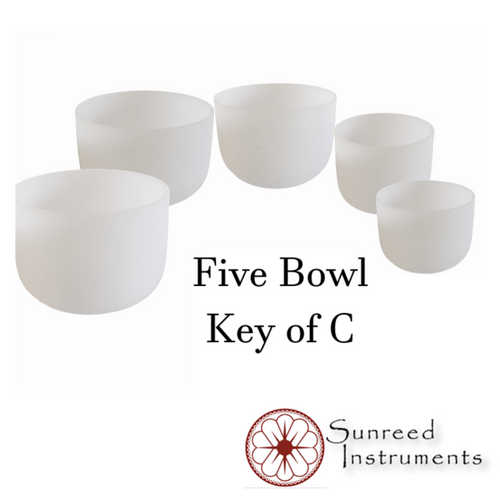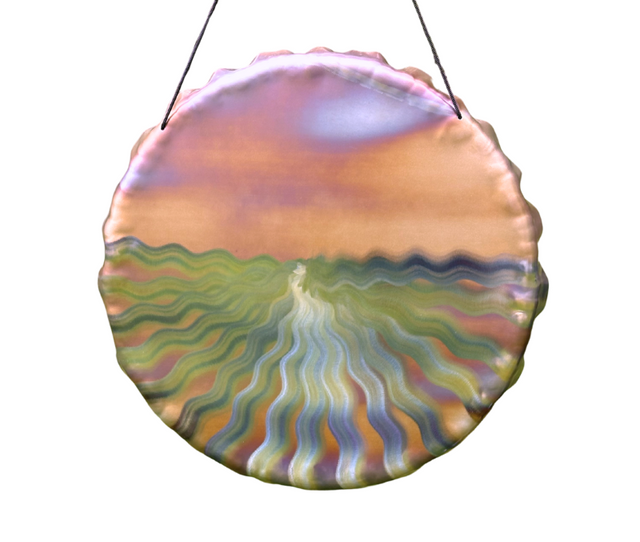What Are Binaurals and How Do Binaurals Work?
A ‘binaural’ is a beat pattern which occurs when two sounds that are very close together, play at the same time. One hears, in this case, the individual sound of the two bowls, but there is also a third sound, an oscillation, that occurs. It is a beat pattern, a “wah-wah-wah” pulsation in the air, that is felt and heard. To understand this, imagine you are near a still pool of water, and drop a stone at one end of it, then drop another at the other end. You see the wave forms flowing rapidly out from each rock across the pool, in a synchronous fashion, just wave within wave, until they hit the other. As they hit, and collide, they create other oscillations, or waves, that are more ‘chaotic.’ This is fundamentally what would be happening acoustically in a field of sound as you create a binaural wave pattern with the two bowls which have nearly the same frequency, or pitch. We can hear, and feel this binaural pattern emerging from the sounds of the two bowls, as their wave forms strike each other. This binaural pulsation effects our minds and bodies. And one can use this to deepen a practice therapeutically with one’s groups and clients. Again, with right approach, we can use it to clear the mind, untangle emotions, come into a deep, vast, restful space, and with correct understanding, move into other aspects of consciousness in which we may wish to work.
You can hear a binaural through your speaker if you play the two sound files below at the same time. This is a 6hz (hertz) binaural, meaning the hz values are 6hz apart, and the oscillation is also pulsating 6 times per second. Hertz is the value we give to wave speed, or frequency, as cycles per second, and is a standard method of measuring pitch of bowls, other instruments, and, really, all sounds.
Decades old research shows that our brains are constantly giving off wave patterns, from near 0 hz to over 100 hz. These are categorized into ‘brain states.’ Science has shown that, while all of these states are being produced by our brain functions simultaneously, there is primarily a predominant one which relates to these various states. If we are in normal wakeful mode, washing the dishes for instance, we are most likely in a dominant Beta state. As we rest to sleep, we would move through the Alpha, Theta, to Delta states, moving into more inner quiet, reflective, Alpha state (this is where we might have ah-ha’ insights or ideas as we drift to sleep) meditative state, and then sleep.
Brain State Frequency Brain states
Gamma (γ) 20-40 Concentration (most current science we have seen is focusing on 40 hz)
Beta (β) 12–35 Hz normal waking state of consciousness when attention is directed at cognitive tasks and the outside world (some scientists will say 12-20 hz)
Alpha (α) 8–12 Hz Very relaxed, passive attention, focused learning
Theta (θ) 4–8 Hz Deeply relaxed, inward focused, meditative, mystical states
Delta (δ) 0.5–4 Hz Sleep
All states are constantly being produced. But there is a dominant state based on our current focus, mental and emotional attitudes, and intents. Science has learned to use these states to help us improve certain behaviors. If we need help sleeping, we listen to music or sounds emanating the Delta state. If we want to learn to meditate better, or enhance our meditative practice, we work with the Theta beat. Students and athletes have been using music tuned to the Alpha beat for decades, with excellent research showing how it can benefit focused learning, for tests, or athletic skill development for instance. Beta is our normal waking state in which we are engaged in the 3D world, in getting tasks done, and so forth. The Gamma state is getting a lot of scrutiny these days, as scientists at MIT and other Research Universities are discovering it appears to improve memory and learning, and may stimulate the activation of a protein in the brain which eats plaque. The buildup of plaque in the brain is one causative factor in Alzheimer’s disease. And, they literally are using this beat pattern to see if it may help. There is also a great deal of excitement around research indicating this may be the brain pattern that gives rise to the ‘binding principle’. How do we ‘know’ what we see, hear, and feel? What binds consciousness to perception? It is an age-old question with philosophers and scientists, and new evidence is bringing study to this brain state. There are other more short lived higher frequency states that we will not investigate today.
Again, these continually co-generate an electromagnetic field from the brain. But the dominant frequency at any given time is what ‘state’ we are focused most definitively in. So, you may already see how, by producing a “Theta” Beat pattern with two bowls tuned to the right hz values, can assist us in our meditative states and inner healing journeys. By simply ‘resting’ in the sounds of the two bowls and their beat pattern, receptively, we ‘entrain’ to this brain state. Entrainment is a natural scientific principle, in which all things seek communion, and come into resonance with the dominant sound or foce in its environment. (We can talk about the many effects of entrainment in nature, humanity, and the world another time. But it is important to understand in your practice.)
Our bodies do the work for us. In this case, our neurology. Our inherent response to the binaurals, is to let go of any thoughts or emotions that are keeping us from going deeper into this state of entrainment. This is where it is helpful to develop your skill before using these with others. The cognitive brain tends to ‘not know what to do’ with these sounds, and, unless resistant, will tend to slip away, to allow the deeper, more perceptive, awake, intuitive, emotional, and coherent aspects of ourselves come forward to deepen our work. One need for your skill development, is that 1) some of your clients or sound participants may resist, even ‘not like’ this sound, even want to leave the room. For those few, it is uncomfortable, often because it 2) may require us, as we let go of ‘normal states’ or mental/emotional behaviors, to move into hidden emotions, thoughts, or unresolved experiences waiting to be met. To help your clients/participants in these moments does request skillful means.

























